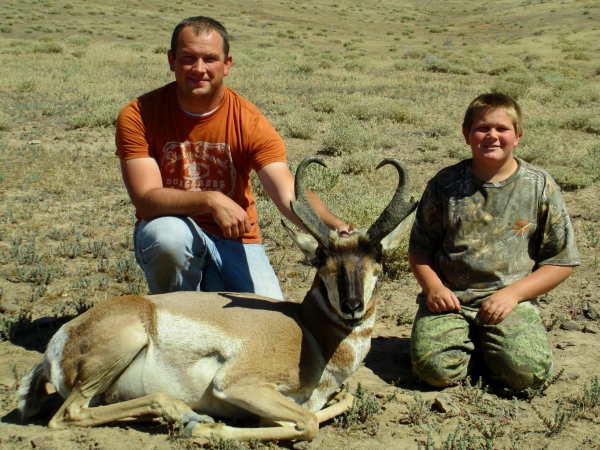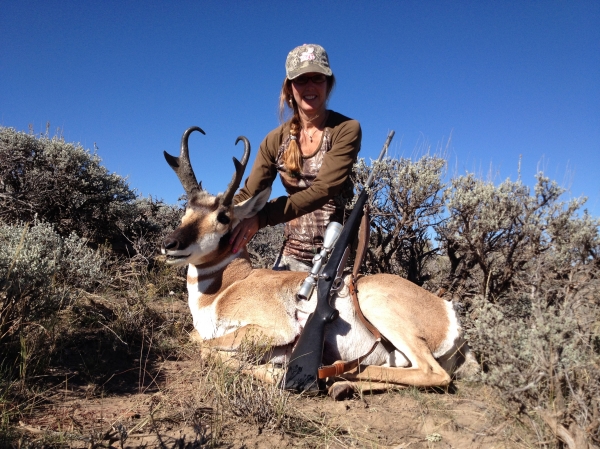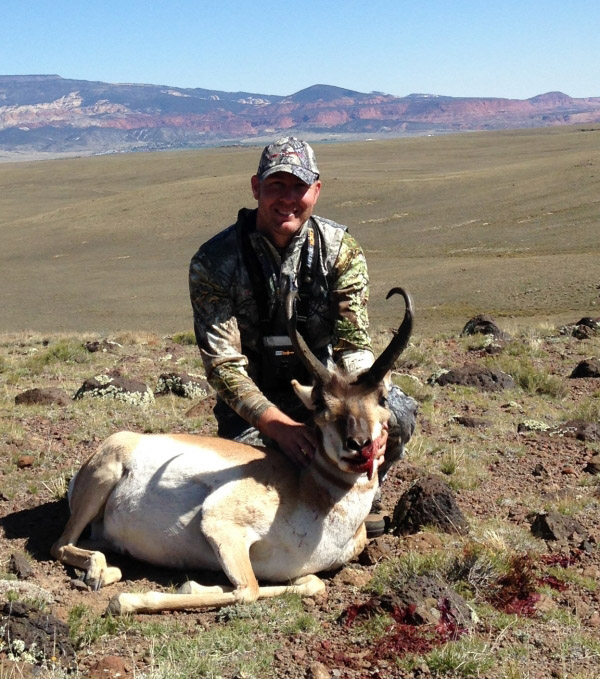By Brad Vargo
John's 76-Inch Speedgoat |
Now that you have made the decision to go on a hunt for pronghorn antelope, you must decide on a state and a unit to hunt in. This is where you will need to do a little general research. The majority of the information you will need can be found on the various state's fish and game websites. For first-timers, I usually recommend starting with Wyoming as they give out the most tags of any state and even have a few leftover tags each year. On a good year, there are more antelope in Wyoming than the rest of the states combined. Additionally, Wyoming has lots of public land and pretty good trophy quality. In fact, according to Boone & Crockett, Wyoming has the most record book entries of any state. Here is the current list:
|
1. Wyoming 2. New Mexico 3. Arizona 4. Nevada 5. Montana |
1,160 632 344 291 184 |
6. Colorado 7. Texas 8. Oregon 9. Utah 10. South Dakota |
161 155 147 94 82 |
| [January 2015] | |||
Since this article is a beginner's guide, you do not want to spend too much time on trophy quality for your first hunt. Get at least one antelope hunt under your belt before you go on a trophy hunt. Many beginning antelope hunters have saved points for many years for their first hunt in a really good trophy unit and have wasted their opportunity by harvesting just an average or below average animal. With the exception of mountain goats, antelope are the hardest animal in the West to judge in the field. For your first antelope, shoot for a good representative of the species. You want a buck with at least 12-14 inch horns, good prongs, and decent mass. For some basic field judging tips, take a look at Boone and Crockett's Pronghorn Field Judging Guide at: http://www.boonecrockett.org/bgRecords/records_FieldJudging_pronghorn.asp Once your initial research is done, make your final decision and get your application in ahead of time.
Once you have drawn your antelope tag, now the real research and planning starts. So you do not get overwhelmed, break the research down into the following three parts:
1. Logistics (how many trips/days, how to get there, where am I going to stay)
2. Selecting your primary and at least two additional hunting areas
3. Equipment
Wyoming Pronghorn Hunting Fun |
The first thing you need to do is order a set of BLM maps for your area. Some companies, like mytopo.com, make single BLM maps with your hunting unit boundaries on them. This is a nice feature as some larger units may require four or more BLM maps to cover your unit. It is also not a bad idea to purchase a state specific hunting chip for your GPS. This makes it virtually impossible to trespass on private grounds. Another good research tool is either Google Earth or National Geographic Alltrails map service. This allows you to see new roads/trails or to help verify potential water sources, though depending on the age of the satellite images, you will still need to verify the information in person during scouting. Once you have your detailed maps, call the biologists, game warden, and range manager again and talk about specific places the antelope like to hang out or areas off the beaten path that may get less hunting pressure. Make sure to have several potential hunting areas identified and make sure to check them out during your scouting period before the hunt starts. You need to continue this phase right up to the hunt. The more time you put in here, the more reward you will get out of the hunt.
Equipment selection for antelope hunting is very important. The average shooting distance of antelope harvested is the longest of any big game animal in the West. Add that to the fact that they also offer the smallest target and this can complicate things for the hunter. You can use your normal deer or elk rifle for antelope, but just ensure that it is very accurate and has a decent power scope on it. Shoot it at the distances you are most comfortable with to verify the trajectory and group sizes so you will know how close you must get for a shot. Most antelope are shot from the prone position and the only other position you need to practice on is the sitting position. Purchase a good set of bipods, one for prone and one for sitting, and practice with them. Keep the prone bipods on when you are hunting as 90% of your shots will be prone. Sitting bipods are needed when there is a small rise between you and the antelope with no way of getting closer.
Good quality optics are needed for locating and judging antelope. A set of 10x or 12x binoculars and at least a 25x spotting scope will save you miles of walking when hunting. You will be able to tell if a herd has a good buck in it from several miles away. It is also a good idea to have a laser rangefinder, a small wind meter to judge the wind, hard plastic knee and elbow pads (duct tape will work too), and thick leather gloves that cactus cannot penetrate. When antelope hunting, it is not if you are going to get cactus needles stuck in your skin, but how many…keep a good pair of tweezers in your hunting pack. If you are camping, make sure your tent can standup to high winds. Antelope country is also very conducive to using a game cart. You will need a good 4-wheel drive with a good set of all terrain or mud tires as the roads can be impassable when they get wet. Make sure you have a couple of spares. Some antelope areas can be remote and you can get multiple flats without ever leaving the BLM roads. An ATV can be a beneficial and cost effective way to get around on the BLM roads and trails, but most BLM trails that are open to motorized travel can be navigated safely with a 4-wheel drive truck or SUV. On a side note with regards to vehicles, antelope will flee when they see a white vehicle. The exception to this is in heavy traveled oil roads where they are used to seeing white trucks driving year round. Bring plenty of good sized coolers to hold your game. Use a combination of ice blocks on the bottom with dry ice on the top to last for the week. Now that you have your equipment settled it's time to focus on some scouting and hunting techniques.
Matt's Smokepole Speedgoat |
When it is finally time to hunt, stay off the ridgelines and do not silhouette yourself (you or your ATV/vehicle). Stop your vehicle or ATV before a ridgeline and walkup to look over. Use the natural terrain of the land to sneak up within shooting range of your buck. Be prepared to crawl on your hands and knees or even facedown the last little bit. Antelope are more easily stalked in the predawn then in the middle of the day. Antelope will usually water sometime during the day, so sitting by a water source can be a very effective technique. If you absolutely have no terrain available for a stalk, you and your buddy can imitate a cow or a horse. Don't laugh; they even make decoy suites for that! If you find a big buck close to the trail when driving, slow down get out quickly and have your buddy slowly drive down the road. The buck will watch the truck and give you enough time to legally get off the trail and execute the shot.
If you are wanting to archery hunt antelope, the most effective way to hunt them is to sit in a blind over a water source. Antelope use the same water source every day and you can pattern them from long distances by using your spotting scope. You can also use a buck decoy to lure them in during the rut. Setup as close as you can get to the buck then popup the decoy. Once they see it, a dominant buck will usually run straight towards you sometimes stopping within bow range. Lastly, you can stalk them, but this is extremely difficult and only the most experienced archers are usually successful with this method.
Once harvested, antelope hair is extremely delicate so be careful when caping out your trophy. Try not to get any blood on the white part of the cape because it may stain. If you do, you can use water to get it off, but just gently pat the cape dry before you store it. Get the cape on ice as soon as possible in order to prevent slippage and store it skin to skin. Antelope make strikingly beautiful shoulder mounts with their jet black horns and black facial markings. After harvesting one of the West's most unique trophies, hopefully you will continue to hunt this most magnificent animal.
Click-a-Pic ... Details & Bigger Photos
Click-a-Pic ... Details & Bigger Photos
Videos | Hunts & Tags | About Mule Deer | About Elk
Classified Ads | Photo Tours | About this Site | Advertising |
Older Content | Email Us | Privacy Policy
